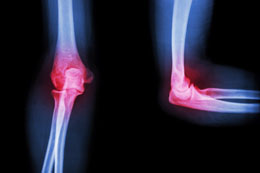Elbow bone spurs are localized over-growths in the bone structure at the elbow. They are usually painless unless they pinch nerves or tissues, in which case they have to be removed. A simple surgery called elbow bone spur surgery should take care of that for you, without putting you out of action for long. This article will answer your doubts about this surgery.

Bone spurs, also called
Osteophytes, are bony projections which occur at joints to help proper weight distribution across a damaged joint surface. Although these spurs in themselves are harmless, they are an indication of other underlying problems which require attention. Spurs can prove to be a nuisance, and once they start pinching tissues/nerves they become quite painful. They will limit the movements of your arm, which can be a deterrent in case you are a sports player. In such cases, the best option is to remove these over-growths.
Types of Bone Spur Surgery
The only way of getting rid of painful bone spurs is surgery, since tablets or external treatments will not work on reducing bone projections. In this article I will try to shed light on the surgical procedures for removing spurs. There are broadly two methods of performing surgery:
- Traditional Open Procedure
- Arthroscopic Elbow Surgery
A quick comparison of both these methods should help in deciding which one is more beneficial.
Open Surgery
Arthroscopic Surgery
This is the traditional type of surgery where the incisions are big and are used to visualize the surgery.
This is an advanced method which inserts a micro-camera into the joint to help carry out the surgery, with very small incisions.
The incisions are a few inches (6-8) in size, depending on the size of the instruments to be used.
The incisions are a few millimeters in size since the instruments used are also very small (sizes are usually between 4-5mm).
It is highly invasive and incisions need stitches to heal, usually leaving behind scars.
It is mildly invasive and incisions usually don't require stitches, as only a sterile dressing is enough. Scars are barely noticeable.
The risks associated with open surgery are more.
Risks in this type of surgery are a lot less due to minimal invasion.
Recovery takes a long time and complications may arise.
Recovery is faster and complications are usually absent.
Clearly, Arthroscopic Surgery has more advantages. Hence, it is more popular.
Overview of the Surgery
Here is a summary of elbow arthroscopy or elbow bone spur surgery.
- The surgeon makes a few tiny incisions, called 'portals', to insert the arthroscope and operating instruments into the joint after administering local or general anesthesia.
- The arthroscope is a fiber-optic light source with a camera attached to its end. The camera aids the surgeon to see the inside of the joint, and the instruments which are inserted without making too big an incision. The incisions are only a few millimeters long.
- The arthroscope is attached to a TV monitor which the surgeon uses throughout the surgery to watch what he is doing.
- The instruments used are punches, microscissors, shavers etc which are all a few millimeters in size.
- Once the surgery is done, the surgeon will remove the instruments and the camera and dress the incisions, since stitches are usually not required. An ice pack is applied to reduce any swelling that occurs.
Risks and Recovery Time
Remember to opt for a bone spur surgery only if the spur gets painful. A few risks associated with this surgery are as follows:
- Internal Bleeding (at the elbow joint), causing pain and swelling.
- Infection in the Joint.
- Damage to any major nerve/cartilage around the Joint.
- Blood Clots
The risks stated above are more likely in case of open surgery and the chances of their occurrence reduce in case of arthroscopic surgery.
The normal recovery time in case of arthroscopic surgery is, on an average 8 to 12 weeks. But you should get back to work only when moving your arm causes you no pain. Rest and physiotherapy is the best option as long as the pain persists. Following the doctor's instructions about physiotherapy will help you bounce back from surgery in no time!


 Bone spurs, also called Osteophytes, are bony projections which occur at joints to help proper weight distribution across a damaged joint surface. Although these spurs in themselves are harmless, they are an indication of other underlying problems which require attention. Spurs can prove to be a nuisance, and once they start pinching tissues/nerves they become quite painful. They will limit the movements of your arm, which can be a deterrent in case you are a sports player. In such cases, the best option is to remove these over-growths.
Bone spurs, also called Osteophytes, are bony projections which occur at joints to help proper weight distribution across a damaged joint surface. Although these spurs in themselves are harmless, they are an indication of other underlying problems which require attention. Spurs can prove to be a nuisance, and once they start pinching tissues/nerves they become quite painful. They will limit the movements of your arm, which can be a deterrent in case you are a sports player. In such cases, the best option is to remove these over-growths.